Toilet and Bathing Etiquette in Japan
While Japanese public bathroom manners are extremely tidy, some ways and means may at first make western travelers uncomfortable.
by Nancy Kerstetter
Relax. You may have heard tales of bathroom adventures in Japan or other parts of Asia. You have no need to worry. From operating a musical toilet to using a floor facility, there is a protocol for using Japanese restroom and bathing facilities. These are for your good and the well being of those around you. With some exceptions now and then, Japanese washroom are much more clean than those in most of the rest of the world. And the Japanese keep them clean.
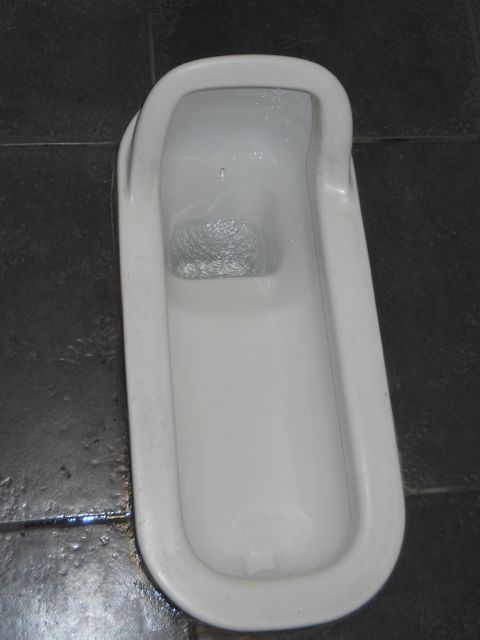
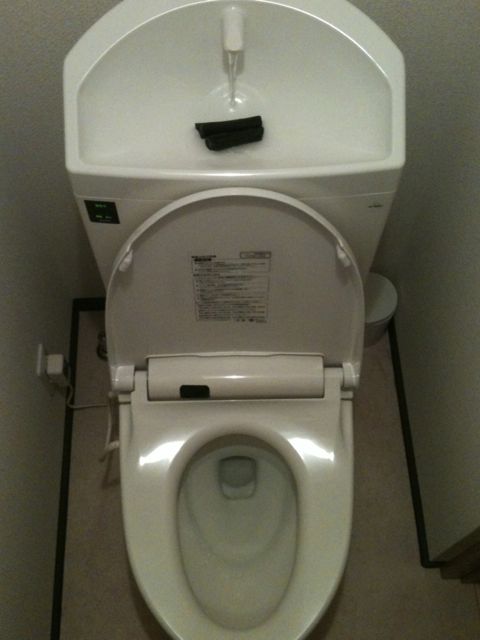
Japanese floor toilets are found throughout Japan in both large cities and rural communities. They are clean and easy, once you know how to use them. Western-style toilets — vastly improved by Japan — are common throughout Japan. They boast amenities such as heated seats, and select water flows. Try it.
While tourist and business hotels offer Western toilets and private bathrooms, many accommodations provide shared restrooms and washrooms. Before traveling to Japan, learn the expected etiquette to avoid embarrassing yourself or your host.
While toilet and bathroom etiquette in Japan is very hygienic, some Westerners may at first feel awkward because of the differences. Rest assured, After a day or two, you become comfortable as you begin to understand this small part of the Japanese Way.
Floor Toilets and Seat Toilets
Japan uses both floor toilets and seat toilets. You can them both in public facilities and shared facilities, such as hostels and ryokans.
Use a floor toilet once, following the instructions later in this article, and you will never worry about them again.
Use a Japanese-improved western toilet once and you will want to install one in your private bathroom once you get home.
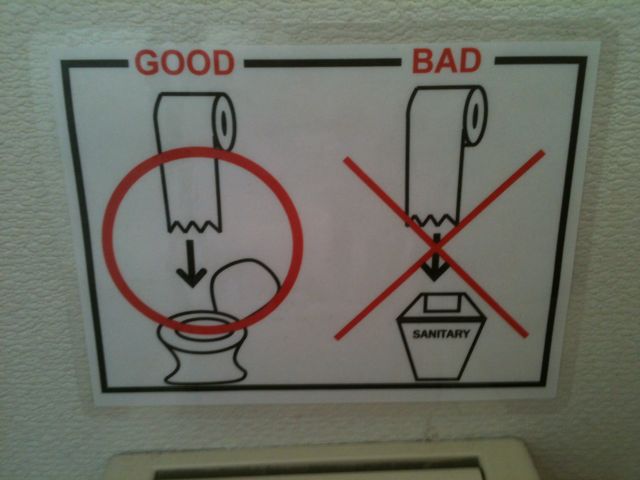
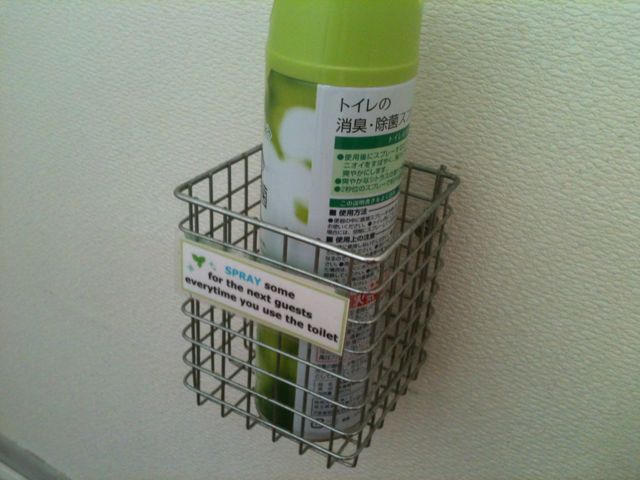
While there may be exceptions, in most Japanese washroom you place your paper in the toilet and then flush it. Some shared facilities provide you with spray to neutralize odors.
Shared Washroom Cleanliness
Some Japanese accommodations provide shared toilet and washroom facilities. These shared washrooms with sinks and mirrors may be separated by gender or could be mixed gender, much like you find in public restrooms in Europe. This personal hygiene area is provided for guests to wash hands or face and brush teeth as if at home.
Always tidy up around the sink when you are finished. In a ryokan, hostel or traditional inn, you should wear your regular indoor slippers in this section of the comfort area.
Toilet Area and Slippers
In shared facilities, a separate pair of slippers are used in the toilet area. You share the slippers with others. The bathroom slippers are often made of polished wood and slightly raised. They can be found outside the bathroom door or just inside. Switch from your house shoes to toilet slippers to use the toilet, then switch back to house shoes before reentering the washroom area. Toilet slippers are not allowed in that area or the rest of the inn. This is a crucial part of bathroom etiquette.
In public restrooms in airports, castles, parks, zoos and shopping areas, as examples, you stay in your street shoes.
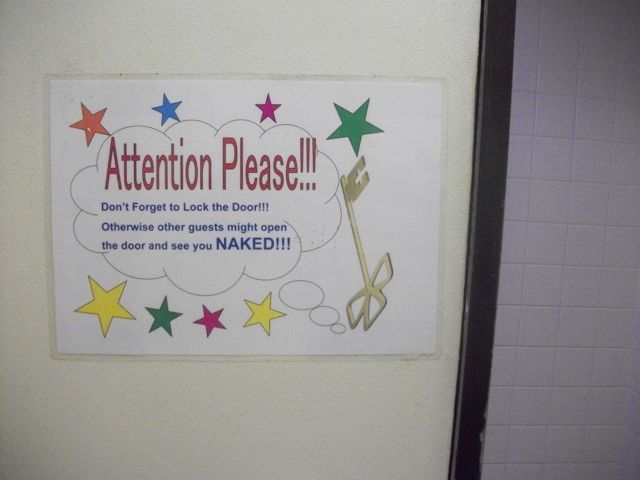
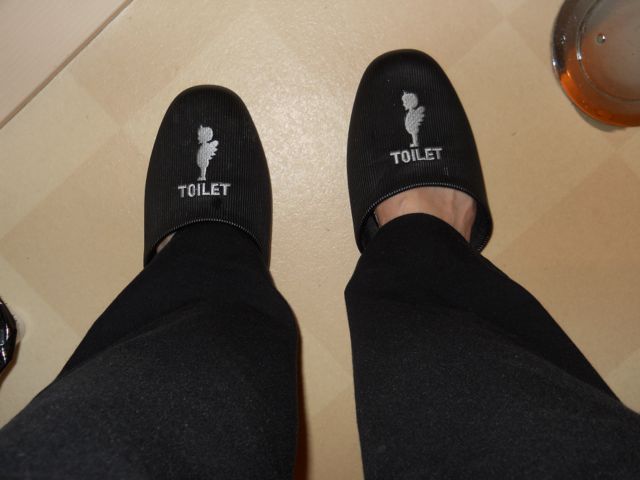
This sign reminds uses of a shared co-ed shower facilities to lock the door before undressing — shared does not mean simultaneous. Toilet slippers are common in shared facilities you find in ryokans, inns and hostels.
Western-style Toilets
Tourist and business accommodations typically provide Western-style toilets even if the bedroom is Japanese-style. Japan’s toilets are high tech. A control panel offers various options such as music, bidet, blow drier, seat warmer and Otohime, which makes a flushing noise to mask sounds the person using the toilet may be making. This is often referred to as the Princess setting and is found in hotels and women’s restrooms.
While pictorial icons label the high-tech-toilet buttons, if you are uncertain about a feature, use the "don’t touch" policy until you find out, or you may experience an unwelcome surprise–nothing to hurt you, but you may get a bit damp with clean water. (As a visitor to Japan you may ask questions without fear of embarrassment. The Japanese may bow to you before explaining as best they can. Most Japanese are very polite to visitors.)
Often you have the choice between two flushes. A small flush uses less water and force; a large flush is for solid waste. At a private residence or apartment, you might encounter a toilet with a faucet mounted on the reserve water tank at its back. This is for washing hands in the toilet room. It conserves water by offering clean water to wash hands that will then be used for the next flush.
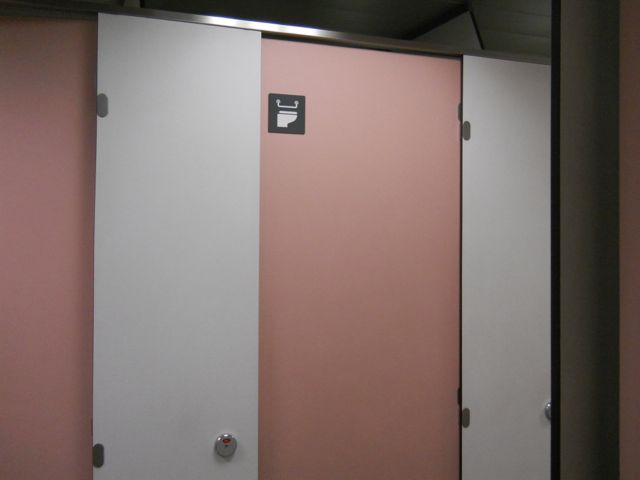
Public restrooms often have a sign on the door of the stall to indicate whether the toilet is Western or Asian in style.
Asian-style Floor Toilets
Floor toilets are found in many countries of Asia from India to Vietnam to China. Try using a ceramic floor toilet while in Japan for the experience. Take your garments down below your knees. Straddle the unit facing the protruding hood. Squat low to avoid splashing yourself or your clothes. Flush by using the button, sometimes near the hood, sometimes on the wall. The more you you these, the more comfortable they become.
Bathing
Tourist and business hotels with private bathrooms feature a familiar shower and tub combination. The tubs are deeper than those in America to facilitate soaking after showering. In traditional inns or ryokan, shower rooms are separated by gender. You sit on a low stools in front of a shower wand and faucets.
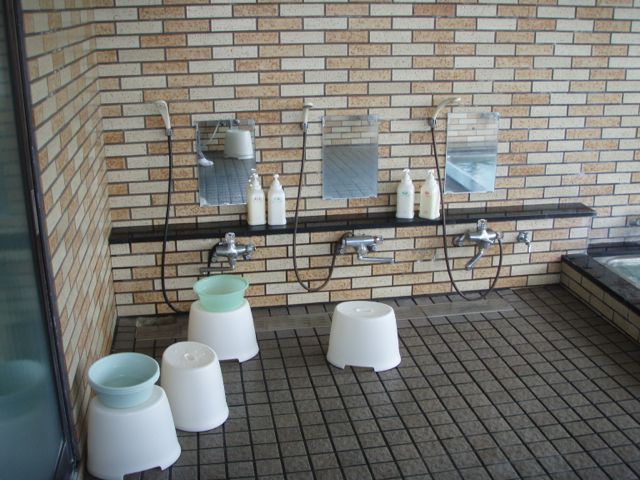
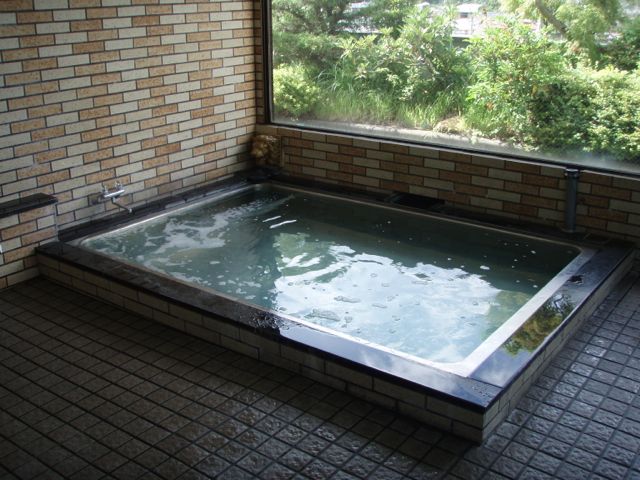
At shared facilities you always bathe before soaking in hot water. Here you bathe while seated on a stool in a common shower area. You then soak in the mineral water bath.
Leave your clothes in the changing area baskets provided. Enter the bathing area naked except for your privacy cloth, a small washcloth sized towel to cover your privates. The privacy towel may be optional, depending on what others — especially the locals — are doing. Sit on the stool to wash your body and shampoo your hair. Rinse thoroughly before entering the bath.
The hot bath is for soaking and relaxing. That is why you need to be totally clean and soap-free. Also other persons will use the same water. If others are already in the bath, just find a spot that is unoccupied and sit down. Do not put your privacy cloth in the water.
Some traditional accommodations also offer private shower stalls as an alternative for bathing.
Tips Regarding Public Restrooms
Public restrooms in heavily populated areas tend to offer Western-style toilets. However, if you travel into more rural settings, you will find floor toilets predominate. Public restrooms often have a small picture of the toilet posted outside the stall, making it easy for visitors to make a selection between Western or Asian toilets.
Many restrooms offer soap and water, but not all have a hand dryer or paper towels. A handkerchief may come in handy for drying your hands. It is a good idea to carry a few squares of toilet paper or tissues in your pocket as some restrooms do not supply toilet paper. You will find that carrying a small container of hand sanitizer is also handy for impromptu hygienic needs.
Additional Information
Japanese Bathroom Etiquette: http://www.japanesebathtubguide.com/japanese-bathroom-etiquette.html
Japanese Toilets: http://www.japan-guide.com/e/e2003.html
International Center for Bathroom Etiquette: Japan: http://www.icbe.org/international-bathrooms/japan/